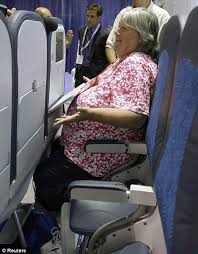 Q – Given that I am a multi-state franchise territory manager, I guess you could say I’m a very frequent flyer. As a large man, I’ve started noticing that sometimes my economy seat feels like I actually have a squoosh more room but for the most part, it seems like the seats are getting smaller. I was talking to another frequent flyer on a flight to Minneapolis last week and he swears the seats are, despite what the airlines might say, actually getting smaller. I told him I knew who to ask.
Q – Given that I am a multi-state franchise territory manager, I guess you could say I’m a very frequent flyer. As a large man, I’ve started noticing that sometimes my economy seat feels like I actually have a squoosh more room but for the most part, it seems like the seats are getting smaller. I was talking to another frequent flyer on a flight to Minneapolis last week and he swears the seats are, despite what the airlines might say, actually getting smaller. I told him I knew who to ask.
A – The web site, Seatguru.com actually studies this stuff and they have compiled some interesting statistics that clearly demonstrate that seats have been getting narrower in the back of the plane.
 In the 1970’s, the average seat width on America’s major airlines was 18″. In the 1980’s, a rather competitive decade for the airlines, seating increased to 18.5 inches. But currently, seat average are down to 16.5 inches of width. Meanwhile, the average male passenger weighed 173 pounds. Today, the average male passenger weighs in at 196 pounds in a significantly narrower seat. So you are not imagining anything.
In the 1970’s, the average seat width on America’s major airlines was 18″. In the 1980’s, a rather competitive decade for the airlines, seating increased to 18.5 inches. But currently, seat average are down to 16.5 inches of width. Meanwhile, the average male passenger weighed 173 pounds. Today, the average male passenger weighs in at 196 pounds in a significantly narrower seat. So you are not imagining anything.
Airlines in the 1970’s flew at 70% capacity with 17 inches as the average seat width. Today, most airlines are maintaining 85% capacity loads.
Airbus has partnered with the London Sleep Center and determined that an 18 inch seat in coach will actually enable a passenger on a night flight to experience a “53% improvement in overall sleep quality”. As a result, Airbus has been calling for a mandatory 18″ seat width as industry standard.
If you want to understand how this all really works, look at a company called Recaro Aircraft Seating, a major industry player. They claim the airlines have been asking them to make seats that are both smaller and more comfortable. To achieve this, according to CNN, the company has slimmed down armrests to give passengers more room for their over-sized hips and they have moved the literature pocket above the tray table which, at least theoretically, increases leg room. They are also working with a netting material that clings to the body, replacing foam. This creates a bit more legroom.
But, the deal is that airlines can order seating tot heir own specifications and some airlines are more concerned with squeezing in so many seats that comfort is normally unobtainable. We see this on a 777 that is delivered with ten seats across in economy. The airbus 380’s always provide 18 inches of seat width in coach.
So – what to do about all of this. Well to assure the airline’s profits remain healthy we could all go on a nationwide fast and lose 100 or so pounds. But it might be easier to follow the seating charts on Seaguru.com to determine if you are flying in a seat that has been designed for maximum profit instead of maximum comfort.
